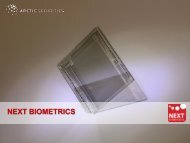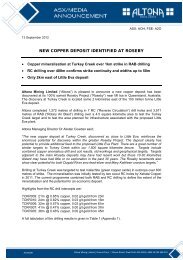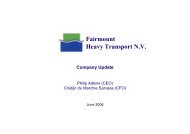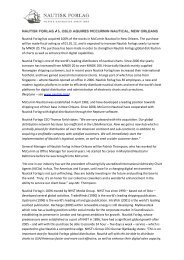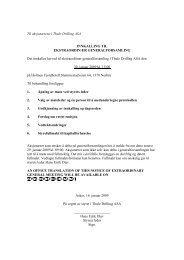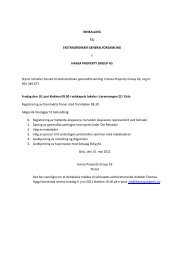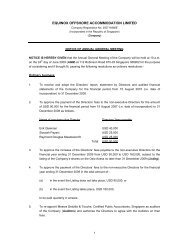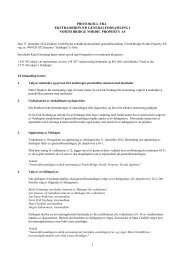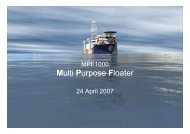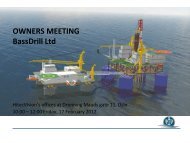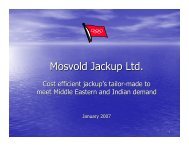Create successful ePaper yourself
Turn your PDF publications into a flip-book with our unique Google optimized e-Paper software.
ments. The interpretation is effective for annual periods beginning<br />
on or after 1 July 2010, but the interpretation is not yet approved<br />
by the EU. The Group expects to implement IFRIC 18 as of 1 January<br />
2011. The Group does not expect that implementation of IFRIC 19<br />
will have a material effect on the financial statement of the Group on<br />
the date of implementation.<br />
<strong>Annual</strong> improvements project<br />
The IASB issued amendments to its standards and the related Basis<br />
for Conclusions in its annual “improvements to IFRSs”. The improvement<br />
project is an annual project that provides a mechanism for making<br />
necessary but non-urgent amendments. These amendments are not yet<br />
approved by the EU.<br />
IFRS 2 Share-based Payment: Clarifies that the contribution of a business<br />
on formation of a joint venture and combinations under common<br />
control are not within the scope of IFRS 2 even though they are outside<br />
of scope of IFRS 3 (R).<br />
IFRS 5 Non-current Assets Held for Sale and Discontinued Operations:<br />
Clarifies that the disclosures required in respect of non-current assets<br />
or disposal groups classified as held for sale or discontinued operations<br />
are only those set out in IFRS 5. The disclosure requirements of other<br />
IFRSs only apply if specifically required for such non-current assets or<br />
discontinued operations.<br />
IFRS 8 Operating Segments: Clarifies that segment assets and liabilities<br />
need only be reported when those assets and liabilities are included in<br />
measures that are used by the chief operating decision maker.<br />
IAS 1 Presentation of Financial Statements: The terms of a liability<br />
that could result, at anytime, in its settlement by the issuance of<br />
equity instruments at the option of the counterparty do not affect<br />
its classification.<br />
IAS 7 Statement of Cash Flow: Explicitly states that only expenditure<br />
that results in a recognised asset can be classified as a cash flow from<br />
investing activities.<br />
IAS 17 Leases: The amendment removes the specific guidance on classifying<br />
land as a lease so that only the general guidance remains.<br />
IAS 18 Revenue: More guidance is added to determine whether an entity<br />
is acting as a principal or as an agent.<br />
IAS 36 Impairment of Assets: Clarifies that the largest unit permitted for<br />
allocating goodwill acquired in a business combination is the operating<br />
segment, as defined in<br />
IFRS 8 before aggregation for reporting purposes.<br />
IAS 38 Intangible Assets: Clarifies that if an intangible asset acquired in<br />
a business combination is identifiable only with another intangible asset,<br />
the acquirer may recognise the group of intangible assets as a single<br />
asset provided the individual assets have similar useful lives.<br />
IAS 39 Financial Instruments – Recognition and Measurement: Clarifies<br />
that a prepayment option is considered closely related to the host<br />
contract when the exercise price of a prepayment option reimburses<br />
the lender up to the approximate present value of lost interest for the<br />
remaining term of the host contract. Clarifies that the scope exemption<br />
for contracts between an acquirer and a vendor in a business combination<br />
to buy or sell an acquiree at a future date, applies only to binding<br />
forward contracts, and not derivative contracts where future actions by<br />
either party are still to be taken. Clarifies that gains or losses on cash<br />
flow hedges of a forecast transaction that subsequently results in the<br />
recognition of a financial instrument or on cash flow hedges of recognised<br />
financial instruments should be reclassified in the period that the<br />
hedged forecast cash flows affect profit or loss.<br />
IFRIC 9 Reassessment of Embedded Derivatives: The scope paragraph<br />
is amended to clarify that the interpretation does not apply to possible<br />
reassessment, at the date of acquisition, to embedded derivatives in<br />
contracts acquired in a combination between entities or businesses<br />
under common control or the formation of a joint venture.<br />
IFRIC 16 Hedges of a Net Investment in a Foreign Operation: The<br />
amendment states that, in a hedge of a net investment in a foreign<br />
operation, qualifying hedging instruments may be held by any entity or<br />
entities within the group, including the foreign operation itself, as long<br />
as the designation, documentation and effectiveness requirements of<br />
IAS 39 that relate to a net investment hedge are satisfied.<br />
The Group does not expect that implementation of the amendments<br />
listed above will have a material effect on the financial statement of the<br />
Group on the date of implementation.<br />
2.2 Consolidation<br />
(a) Subsidiaries<br />
Subsidiaries are all entities (including special purpose entities) over which<br />
the group has the power to govern the financial and operating policies<br />
generally accompanying a shareholding of more than one half of the<br />
voting rights. The existence and effect of potential voting rights that<br />
are currently exercisable or convertible are considered when assessing<br />
whether the group controls another entity. Subsidiaries are fully consolidated<br />
from the date on which control is transferred to the group. They<br />
are de-consolidated from the date that control ceases.<br />
Inter-company transactions, balances and unrealised gains on transactions<br />
between group companies are eliminated. Accounting policies of<br />
subsidiaries have been changed where necessary to ensure consistency<br />
with the policies adopted by the group.<br />
(b) Transactions and non-controlling interests<br />
The group applies a policy of treating transactions and non-controlling<br />
interests as transactions with parties external to the group. Disposals to<br />
non-controlling interests result in gains and losses for the group that are<br />
recorded in the income statement.<br />
(c) Joint Ventures<br />
The group has an interest in a joint venture which is a jointly controlled<br />
entity, whereby the venturers have a contractual arrangement that<br />
26 Marine Subsea <strong>Annual</strong> <strong>Report</strong> 2009



